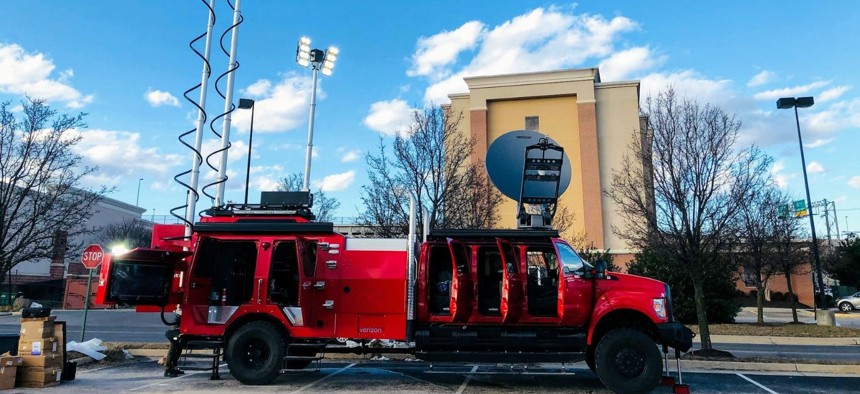Marine Corps Meets THOR, Verizon’s Futuristic 5G-Enabled Response Vehicle

Verizon's Tactical Humanitarian Operations Response vehicle. Verizon
The vehicle is the first of its kind.
This week, the Marine Corps and Verizon deployed the latter’s new, next-generation communication and disaster response prototype—a Tactical Humanitarian Operations Response vehicle, or THOR—at their joint 5G ‘living lab’ on a California military base.
THOR was built to operate under any network in any environment, from dense forests during wildfires to remote military settings.
“At Marine Corps Air Station Miramar this week, we demonstrated THOR’s ability to enable a fully-operational 5G network that allowed: autonomous robot communication to a self-driving battery delivery vehicle, video streaming between people and vehicles in the field, data from sensors on devices operating in an austere environment, and 5G mobile edge computing being used to help decision-makers by providing a single operating picture of all of these data feeds in real-time,” Director of Verizon 5G Labs Christian Guirnalda explained Friday.
Guirnalda and Director of Verizon Response and Public Safety Operations Cory Davis briefed Nextgov on the prototype and its potential impact across the defense and first response landscapes.
Almost a year ago, Verizon and the Marine Corps unveiled their experimental testbed at MCAS Miramar to strategically explore fifth-generation wireless technologies’ potential to support the Pentagon’s pursuits. It marked Verizon’s first-ever 5g Ultra Wideband service deployment on a military base. For DOD, it’s a chance to grow its insiders’ grasp of what the next-level technology is capable of and mature their understanding of how they can best put it to use.
“The first military base with 5G in the United States has seized the opportunity to bring together industry partners and stakeholders across the base to collaborate in new ways and accelerate innovation in their key areas of focus,” Guirnalda said.
Also a first- and one-of-a-kind, THOR is a prototype, 5G-based disaster response and command hub vehicle—and there are no present plans to build another. It has modular, private 5G and edge computing architecture at its core. Davis confirmed it’s designed to be National Incident Management System or NIMS-1 compliant and offers full radio interoperability and onboard Joint Operations Center services. In addition, it provides what he referred to as “a multitude of connectivity options,” spanning private 5G, commercial 4G LTE, Land Mobile Radio and tactical radio, wireless networking, microwave, mesh, and more—together in one package. Other components include 4G/5G radios, a rear command center, a camera, a 6-seat cabin, and an exterior touch screen display.
Davis noted it’s also equipped with a tethered drone to capture an aerial view “that can be fed over the network to devices on the ground and the command center below, potentially helping those in public safety or the military with risk and damage assessment, situational awareness or search and rescue operations.”
“THOR is a bit like a Swiss-Army-Knife on wheels,” he added.
Although 5G technology is more accessible than it has ever been, Davis said in some cases, there remains an opportunity “to boost the network and technological capabilities” of first responders and the U.S. military.
“In situations ranging from fighting wildfires in forests where network connections and coverage can be challenging to the devastation and infrastructure damage caused by earthquakes, public safety professionals face the potential of coverage and technology gaps or an out-of-service network,” Davis noted.
But Verizon built the futuristic vehicle to confront those challenges. “In a field where seconds always matter, and lives are on the line, connectivity and reliability matter,” he added.
THOR consists of the “full menu” of emerging and existing tech solutions. But Davis said future iterations for public safety or the military could potentially go “a la carte.”
“In other words, these Verizon Frontline services can be delivered in a number of different configurations,” he explained.
Guirnalda added that THOR is essentially a proxy for the systems implemented with the 5G commercial network in California.
“The 5G network and 5G Edge, our mobile edge computing platform, will allow the same capabilities offered by THOR to provide permanent transformation at MCAS Miramar,” he said. “Energy management and resilience, EV and autonomous vehicles and supply chains, as well as base services to families, will all be enabled further with 5G.”



